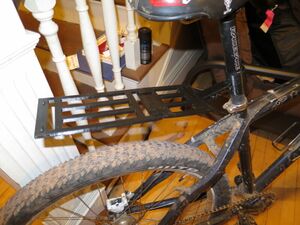Bicycle cargo rack
Project developed by Erik Bain
Template:Statusboxtop Template:Status-design Template:Status-prototype You can help Appropedia by contributing to the next step in this OSAT's status. Template:Boxbottom
Abstract
A bicycle is a common form of transportation in developing countries. It is relatively cheap, fast, and effective. Since bicycles are used for transportation, a cargo rack is a helpful accessory for hauling goods or personal items. A 3D printable cargo rack was designed to fulfill this purpose in a very economical way. The rack is symmetrical and can be easily adjusted in the script for different bike sizes, seat tube angles, and seat tube diameters. It was designed to be modular to further facilitate customization.

Bill of Materials
- 1 mount File:OSAT Bike Rack mount 1.stl SCAD
- 1 180mm rack plate File:OSAT Bike rack 180mm.stl File:OSAT Bike rack 180mm.scad
- 2 Female snap connectors File:OSAT Bike rack female connector.stl File:OSAT Bike rack female connector.scad
- 1 Male connector File:OSAT Bike rack male connector.stl File:OSAT Bike rack male connector.scad
Tools needed for fabrication of the OSAT
- MOST Delta RepRap or similar RepRap 3-D printer
Skills and Knowledge Necessary to Make the OSAT
- If you used special skill – link to relevant wikipedia or wikiversity articles/courses
Technical Specifications and Assembly Instructions
- Provide directions for print/assembly - be detailed enough in your “how to” to ensure that someone could construct the device from your description. Consider the elegance of IKEA like instructions.
- Include print time estimate
- Include assembly time estimate
- Including drawings or pictures of the device at stage of assembly at minimum. (http://www.appropedia.org/Special:Upload)
Common Problems and Solutions
- Include common mistakes/problems to avoid in building your OSAT and how to overcome them
Cost savings
- If your solution is not a low cost one then it is not really appropriate.
- Estimate your costs
- Find a commercial equivalent
- Calculate $ savings and % savings
References
- The sources of information (e.g. engineering handbooks, journal articles, government documents, webpages, books, magazine articles etc.). References should use the <ref> </ref> and <references/> tags and can be in any format but should include all the information necessary for someone else to find the same information you did. For example: [1]
- ↑ web page: Department of Energy (DOE) Landscaping and Energy Efficiency, DOE/GO-10095 (1995) Available: http://www.eren.doe.gov/erec/factsheets/landscape.html
Based on the developmental needs addressed (e.g. food, heat, electricity, clean water, health care, etc.) be sure to label your device in the proper categories e.g. use [[Category:Water]]. Be sure to categorize your device so that it will be easy to find – for example “Low voltage connection basics” is categorized in [[Category:How tos]] [[Category:Electricity]] [[Category:Electric lighting]].